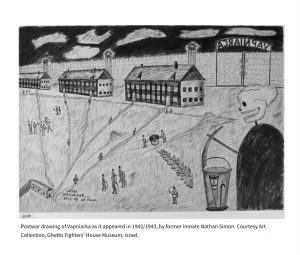The first thing that caught my eye in this image, created by former prisoner Nathan Simon, was the sign signifying the entrance to the concentration camp. Immediately, it evoked the infamous sign that met Jewish prisoners at entrance to Auschwitz. Alongside the drawing’s grayscale, the sign sets the tone for the disaster of Vapniarka, and the Holocaust in its totality (Degeratu 2015, 33-34).
The right side of the image is overwhelmed by a larger-than-life figure, with a skull for a head and adorned in black (seen at the right). At first glance, it could be a perverse interpretation of the biblical angel of death narrative, where instead of watching over the Israelites in Egypt, and therefore the Jews imprisoned in Vapniarka, the angel watches them suffer in the concentration camp, at the mercy of the Romanian guards. However, it seems more likely that the figure represents three of the camp’s commanders: reserve officers Ion Murgescu, Sever Buradescu, and professional officer Cristodor Popescu, all of whom were virulent antisemites (Solonari 2017). Simon also seems to reference Popescu in the scene immediately to the left of the black figure, in which a group of Romanian Guards aim weapons at a group of (presumably) Jewish prisoners using canes. Of the three camp commanders noted above, Popescu was remembered as most dangerous, “even stag[ing] inmates’ fake rebellion in order to have a pretext for shooting into the crowd. (Gendarmes [the Romanian police force], however, refused to implement this order)” (Solonari 2017).
As seen to the left, this certainly could be the moment invoked by the drawing: Romanian guards, menacing the Jewish prisoners. It seems that the figure commanding the guards could certainly be Popescu, who holds the fate of his prisoners at the tip of his walking stick.
Here, as in other places in the drawing, the effects of Lathyrus Sativus and neurolathyrism are brought to light. As per Dr. Arthur Kessler, a doctor imprisoned in Vapniarka, the prisoners suffered from “severe recurrent painful muscle cramps of several minutes duration in the lower extremities…abnormal gait and progressive paraparesis of the lower extremities…[and] painful pollakiuria and incontinence,” which was the result of the forced ingestion of Lathyrus Sativus in their daily diets (A. Kessler in Garfinkle, Andermann, and Shevell 2011, 842). In essence, the prisoners affected by neurolathyrism became paralyzed from the waist down, and unable to control their bodily functions. Here, it seems, Simon represented the debilitating effects of L. Sativus’s consumption by giving the prisoners canes. Regardless, the prisoners were not dangerous: by virtue of their disease and disability, they did not pose a threat against Vapniarka’s guards and leadership.
The canes are likewise relevant to understanding the garbage can situated next to the figure in black. If taking the assumption that the figure represents a conglomeration of Murgescu, Buradescu, and Popescu, then it follows that the trash can is symbolic of the prisoners murdered and maimed under their watch. As already established, the canes likely represent the disability caused by the prisoners’ forced consumption of L. Sativus, and the resulting neurolathyrism. Thus, the cane (and crutch) in the garbage represent the roughly 10 prisoners who died and the roughly 120 prisoners who were permanently disabled because of neurolathyrism (Hirsch and Spitzer 2006, 149). It is necessary to discuss the 120 permanently disabled prisoners because their lives, like all the prisoners of Vapniarka, were drastically changed by the effects of neurolathyrism. As David Kessler, Dr. Kessler’s son, recalled, “There was a string of people coming to our house on crutches…We were surrounded by them. They had special cars, built especially for them. My dad took care of them…And my father would say in German, ‘There are some things children should be spared knowing” (D. Kessler in Hirsch and Spitzer 2006, 138). The internees were permanently disabled by neurolathyrism and the abuse they faced, necessitating the long term care provided by Dr. Kessler in the decades following Vapniarka and the Holocaust.

The communist hammer and sickle. Note the similar shape between the sickle and the pickax in Simon’s drawing. From (“File:Hammer and Sickle.svg.”)
The black figure and its surroundings also help communicate the significance of the Vapniarka camp. Immediately above the trash can (and perhaps being used by the figure to lift it) is what appears to be a wooden pickax. While not exactly the same, this evokes the scythe depicted on various pieces of communist regalia. Simon’s use of communist-like imagery demonstrates that, in the words of Vapniarka survivor Dr. Ihiel Benditer, “Camp Vapniarca was officially declared by the Romanian authorities as a camp for “politicals” (people accused of harbouring ideologies conflicting with Nazism). Therefore, alleged socialists, communists, Zionists and members of Jewish organizations were deported,” and persecuted (Benditer 1995). As such, Simon, by including the pickax in the image, calls attention to the perverse uniqueness of Vapniarka. As Laura Degeratu explains, “those who were imprisoned there were twice guilty. Once for having communist views and the second time for being Jews” (Degeratu 2015, 38).
Simon’s drawing depicts the brutal existence of life in Vapniarka. The entrance to the camp draws parallels to the infamous gates of Auschwitz. The figure, clad in black, represents the cruelty of Vapniarka’s commanders, as does the scene immediately to its left. The canes throughout the image represent the debilitation of the prisoners caused by the prolonged consumption of L. Sativus; the garbage can, their eventual deaths. Finally, the pickax evokes communist iconography and the duality of the prisoners’ “infractions” against the Romanian state: having (or being perceived to have) communist ideas, and (almost always) being Jewish.



